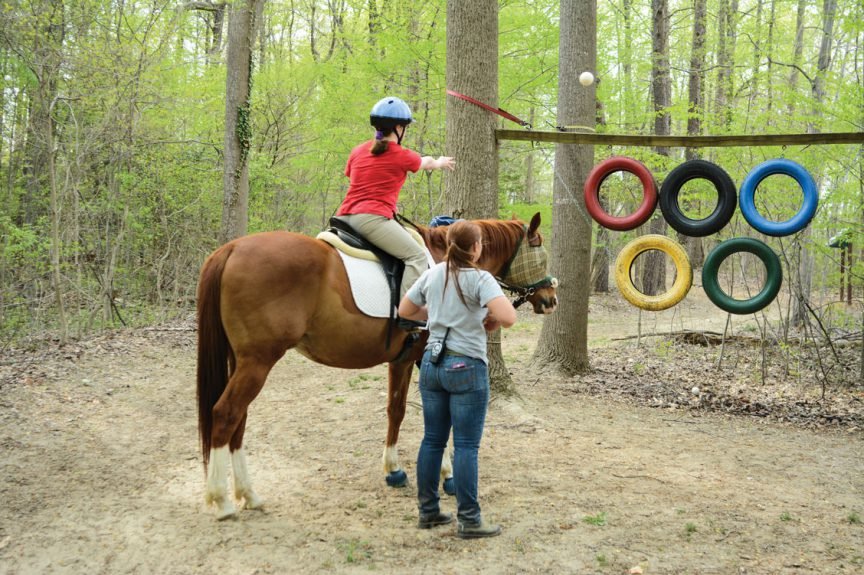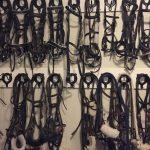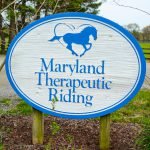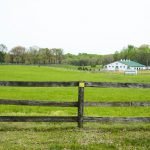+ By Emmy Nicklin + Photos by Marie Jane Machin
“There’s just something about being around a horse,” says Kelly Rodgers in the stables of Maryland Therapeutic Riding (MTR). Outside, rolling green hills—a surprising sight, being a mere 11 miles from downtown Annapolis—drift into an end-of-day glow, while satisfied horses chomp on hay in their stalls and settle in for the night after another hard day of good work. “I don’t know if anyone’s been able to explain it,” Rodgers continues, describing the healing power of horses. “You don’t think that they are that sensitive and intuitive, but they really are.”
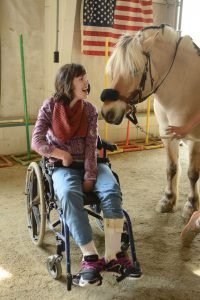 Rodgers is devoted to horses. She grew up riding them and earned her degree in equine business management. For the past eight years she’s served as program director of MTR, a nonprofit organization that seeks to improve the quality of life of those with physical, developmental, and emotional health challenges through human and horse interaction.
Rodgers is devoted to horses. She grew up riding them and earned her degree in equine business management. For the past eight years she’s served as program director of MTR, a nonprofit organization that seeks to improve the quality of life of those with physical, developmental, and emotional health challenges through human and horse interaction.
MTR offers a range of programs, depending on what an individual needs. They include Therapeutic Riding, where instructors teach riding skills, Hippotherapy, in which the rider participates in one-on-one therapy sessions under the guidance of an occupational, physical, or speech therapist, and Equine-Facilitated Psychotherapy, where a mental health professional and equine specialist work as a team to provide a therapy setting to someone working through emotional distress such as depression, anxiety, or trauma.
Equine Therapy is a fascinating concept, though hardly new. Hippocrates wrote of the horse’s power to heal those with incurable illnesses in ancient Greece. Beginning in the 1940s, Equine Therapy grew in popularity across Scandinavia and other parts of Europe, eventually making its way across the Atlantic in the 1970s. Nowadays, there are more than 7,600 facilities around the globe helping nearly 62,000 children and adults.
And they help in profound ways. At MTR, the stories abound—of children who were previously unable to speak saying their first words, of adults in wheelchairs sitting up and trotting, unassisted, on a horse, of military riders suffering from post-traumatic stress disorder finding solace and calm simply by grooming a horse.
Debbie Parry and her daughter Katie have been a part of the MTR community since its inception, 20 years ago. Katie has cerebral palsy and lupus. “[But] when she’s on a horse, she’s no longer in her wheelchair,” says Parry. “She’s doing what her sister can do. She has a little bit of control in her life, for once. A feeling of freedom and empowerment.”
From improving balance, coordination, muscle tone, and flexibility to ameliorating sensory awareness, interpersonal communication, mood disorders, self-esteem, and more, the benefits to riding and simply being around horses are enormous.
 “We’re very goal-focused here,” says Cathy Rosenbaum, who serves as MTR’s executive director. “It’s not that these miracles just happen. There’s a thought-out plan to build upon to make sure that it can happen. And that’s on the part of the instructors, therapists, and the families working together to determine what the goals should be and how to get there. Sometimes it’s riding, sometimes it’s working on their ability to process movement and space and catch a ball while they’re sitting on a horse.” And sometimes it’s the sensory trail ride through the nearby woods, which features activity stations that enhance the rider’s visual, spatial, tactile, and auditory senses—colorful tires dangling from trees, a wooden box full of jars of rosemary, cinnamon, and other fragrant herbs, a bridge that the horse hoofs clatter across at the end of the trail.
“We’re very goal-focused here,” says Cathy Rosenbaum, who serves as MTR’s executive director. “It’s not that these miracles just happen. There’s a thought-out plan to build upon to make sure that it can happen. And that’s on the part of the instructors, therapists, and the families working together to determine what the goals should be and how to get there. Sometimes it’s riding, sometimes it’s working on their ability to process movement and space and catch a ball while they’re sitting on a horse.” And sometimes it’s the sensory trail ride through the nearby woods, which features activity stations that enhance the rider’s visual, spatial, tactile, and auditory senses—colorful tires dangling from trees, a wooden box full of jars of rosemary, cinnamon, and other fragrant herbs, a bridge that the horse hoofs clatter across at the end of the trail.
Each week, roughly 90 riders, ranging in age from 2 to 80, come to Crownsville to connect with one of MTR’s 14 highly trained and selected horses. “I’m amazed by them every single day I’m out here,” says Rodgers of their patience, empathy, and calmness. “They’re worth their weight in gold.”
And she’s not the only one who thinks so.
 Six years ago, Richard Mosher joined the impressive group of 200 MTR volunteers—a range of professionals, including emergency room nurses, attorneys, and teachers, who come to the farm weekly; many say that the experience is just as therapeutic for them as it is for the riders. With hardly any horse experience, Mosher started out by shoveling horse poop five mornings a week. Now he is a volunteer mentor, the board’s treasurer, and is learning to ride. He is impressed with the powerful connection that happens between horse and human. “I can sense the emotion, I see the emotion, but I can’t translate it.” MTR’s mental health professional Trisha Itzel says that such transformations occur in just a few weeks, compared to a typical clinical setting, where the same results may not happen for four months.
Six years ago, Richard Mosher joined the impressive group of 200 MTR volunteers—a range of professionals, including emergency room nurses, attorneys, and teachers, who come to the farm weekly; many say that the experience is just as therapeutic for them as it is for the riders. With hardly any horse experience, Mosher started out by shoveling horse poop five mornings a week. Now he is a volunteer mentor, the board’s treasurer, and is learning to ride. He is impressed with the powerful connection that happens between horse and human. “I can sense the emotion, I see the emotion, but I can’t translate it.” MTR’s mental health professional Trisha Itzel says that such transformations occur in just a few weeks, compared to a typical clinical setting, where the same results may not happen for four months.
Whatever it is about horses, it’s working, in a therapeutic sense—the calm one feels while grooming them, the workout of riding them, the look they give when they are greeted. “A horse is totally accepting of wherever you’re at, and doesn’t really ask for anything in return,” says Rosenbaum. “It’s very powerful. I don’t know how to put it in words, but there’s such a strong connection. It’s like you’re a team—you work together, you take care of each other.”
A few days later, on a rainy Saturday morning, the MTR arena is bustling with young riders. One sits fully upright in her saddle, throwing a ball down to her therapist. Another leans back on his horse and reads from a book with his speech pathologist. Two others slowly but steadily circle the ring, working on balance and coordination. After the boy finishes his book, he holds onto the reins, and with assistance from volunteers on the ground, the horse begins to walk. The boy beams. “I’m riding!” he announces to the world. Wherever and however this little boy started his day, he’s in a far healthier place now. █
To learn more about Maryland Therapeutic Riding,
go to www.HorsesThatHeal.org.

